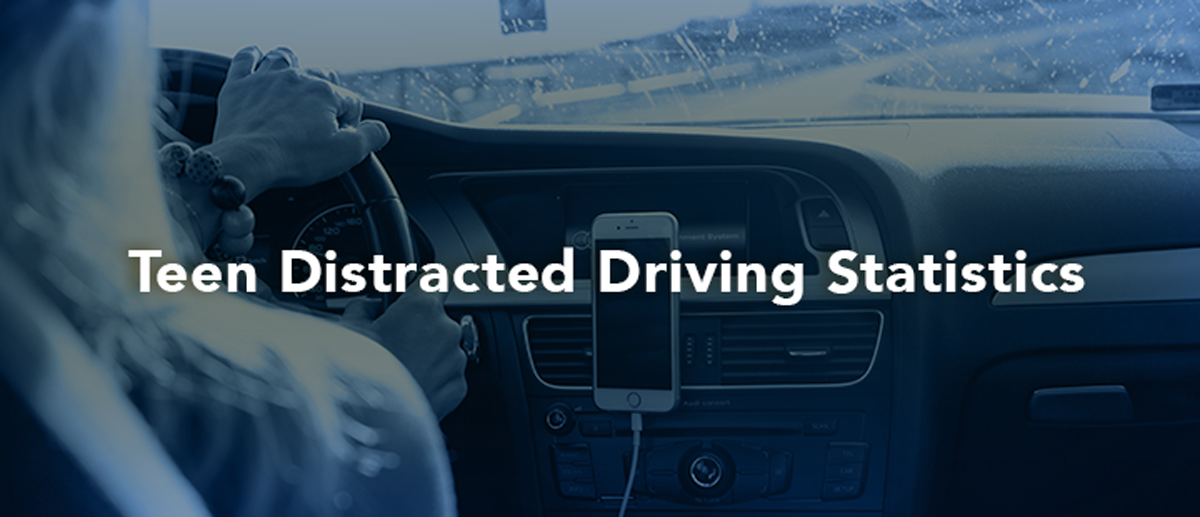Teen Distracted Driving Statistics
For young drivers, distracted driving can be fatal. Knowing and understanding teen distracted driving statistics could be the motivation your teen needs to stay focused when behind the wheel. From taking your eyes off the road to for just a few seconds to adjust a seat or entering a new destination into a phone, it takes less than 5 seconds for a car traveling 55 mph to cover the length of a football field; a lot can happen in 5 seconds.
Teen Distracted Driving Statistics
- 10% of fatal crashes and 15% of injury crashes in 2015 were distraction-affected. NHTSA
- There were 309 Alcohol-Impaired Driving Fatalities (BAC=.08+) in 2018 in the state of Illinois. GHSA/NHTSA
- The NSC estimates that cell phone use alone accounted for 27% of 2015 car crashes.
- The fatal crash rate per mile driven for 16-19 year-olds is nearly 3 times the rate for drivers ages 20+. IIHS
- In 2018, teen deaths were highest between the hours of 6:00 p.m. and 9:00 p.m.—claiming 434 teen lives. IIHS
- In 2018 there were 351 16-17 year-olds that consumed alcohol, operated a motor vehicle and were fatally injured. IIHS
- Everyday nine people are killed and 1,000 are harmed in crashes involving distracted drivers. NSC
- Distracted driving is responsible for over 58% of teen crashes. AAA Foundation for Traffic Safety
- Text messaging requires visual, manual, and cognitive attention from the driver; it is by far the most alarming distraction.
- Five seconds is the average time your eyes are off the road while texting. When traveling at 55mph, that’s enough time to cover the length of a football field blindfolded. NHTSA
- If you text while you are driving, you are 23 TIMES more likely to be involved in a crash. VTTI
- Just talking on a cell phone reduces the amount of brain activity devoted to driving by 37%. Carnegie Mellon University
Learn more about teen distracted driving statistics in Illinois. Read:
- How Parents Can Encourage Their Teen Driver to Limit Distractions
- Important Facts About Distracted Driving
Types of Distractions
- Visual distraction: Taking your eyes off the road.
- Manual distraction: Taking your hands off the wheel.
- Cognitive distraction: Taking your mind off of driving.
Examples of Distracted Driving
- Texting, talking or swiping on a cell phone
- Eating and drinking
- Grooming (makeup, shaving, etc.)
- Reading
- Using a navigation system
- Watching a video or tablet
- Adjusting the radio
- Diverting attention to the passengers in the vehicle
Is Distracted Driving Really a Problem?
Distracted driving kills. The friends, family, and neighbors of the thousands of people killed each year in distracted driving crashes will tell you it is a very serious safety problem. Nearly half a million people injured each year will agree.
Who Are the Most Serious Distracted Driving Offenders?
Our youngest and most inexperienced drivers are most at risk, with 16% of all distracted driving crashes involving drivers under 20. But they are not alone. At any given moment during daylight hours, over 660,000 vehicles are being driven by someone using a hand-held cell phone. As the National Safety Council (NHS) points out, ‘Hands-free is Not Risk Free’ as a driver’s field of view allow is reduced when talking on a phone (hands-free or not).
Is it Safe to Use a Hands-free Device to Talk on a Cell Phone While Driving?
So far, the research indicates that the cognitive distraction of having a hands-free phone conversation causes drivers to miss the important visual and audio cues that would ordinarily help you avoid a crash. While using a hands-free device is a little less distracting, it could still lead to injuries.
What is Considered a Hands-free Device?
- Speaker Phone
- Over the ear headphones or in the ear headphones
- Dashboard Phone Systems
Data released from distraction pilot programs in California and Delaware show effective advertising coupled with increased high-visibility police enforcement of laws could reduce distracted driving over a widespread area. But it’s vital that new drivers understand the severity of engaging in distracted driving and are properly trained with on safe driving tactics to combat the temptation of distracted driving.
Interested in learning more or signing up for a teen Top Driver driving course? View our Illinois, Michigan and Ohio driving programs or contact our team directly.
